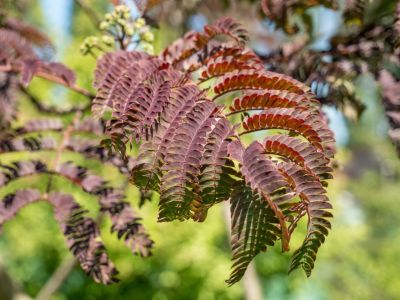Growing Chocolate Mimosa
Not only is the deep chocolate hue of the foliage unusual and elegant, but it also makes care of chocolate mimosa trees easier. The darker foliage makes the tree both accepting of heat and drought tolerant, according to chocolate mimosa information. Deer dislike the odor of the leaves, so you don’t have to worry about these animals munching up your tree. You’ll appreciate the unusual leaf color, but you’ll also love the 1 to 2 inch (2.5-5 cm.) showy flowers, which is the showiest feature of chocolate mimosas that bloom in late summer. The sweet fragrance is lovely, and the flowers attract bees, butterflies and hummingbirds. In time, the pink powder puff flowers develop into long seed pods that look like beans and will decorate the tree all winter. These lovely trees are perfect for your garden, but you may think twice before planting chocolate mimosa trees since their other mimosa counterparts have escaped cultivation in many areas, to the point of becoming invasive. Mimosas spread from seeds and form dense stands that shade and out compete valuable native plants. They can do so much damage to wild areas that the Plant Conservation Alliance has added them to their “Least Wanted” list. That being said, research suggests that growing a chocolate mimosa doesn’t carry the same risks as growing the species tree does. That’s because the ‘Summer Chocolate’ isn’t invasive. It produces far fewer seeds. Nonetheless, you should still contact your cooperative extension agent to find out more about the status of summer chocolate mimosa in your area, just to be safe.
Care of Chocolate Mimosa
The care of chocolate mimosa is easy. The plants are rated for USDA plant hardiness zones 7 through 10. You’ll be amazed at how quickly these trees grow. A chocolate mimosa tree in landscapes should get to 20 feet (6 m.) tall and 20 feet (6 m.) wide. This is about half the size of the green species tree though. Give the tree a location with full sun and moist but well-drained soil. A chocolate mimosa tree in landscapes also tolerates alkaline soil and salty soil. The trees need water until their roots are established, but then become extremely drought tolerant. Apply the water slowly, allowing the moisture to sink deep into the soil to encourage a deep root system. Once established, the tree only needs occasional watering in the absence of rain. Fertilize annually in spring with a complete and balanced fertilizer. Chocolate mimosa trees almost never need pruning. You can, however, make removal of the seed pods a part of your chocolate mimosa tree care routine, if desired. The seed pods are about 6 inches (15 cm.) long and straw-colored, resembling beans, and each pod contains several bean-like seeds. These mature in late summer or early fall. Note: Summer chocolate mimosa trees are protected by a patent, so you should not try to propagate them.
